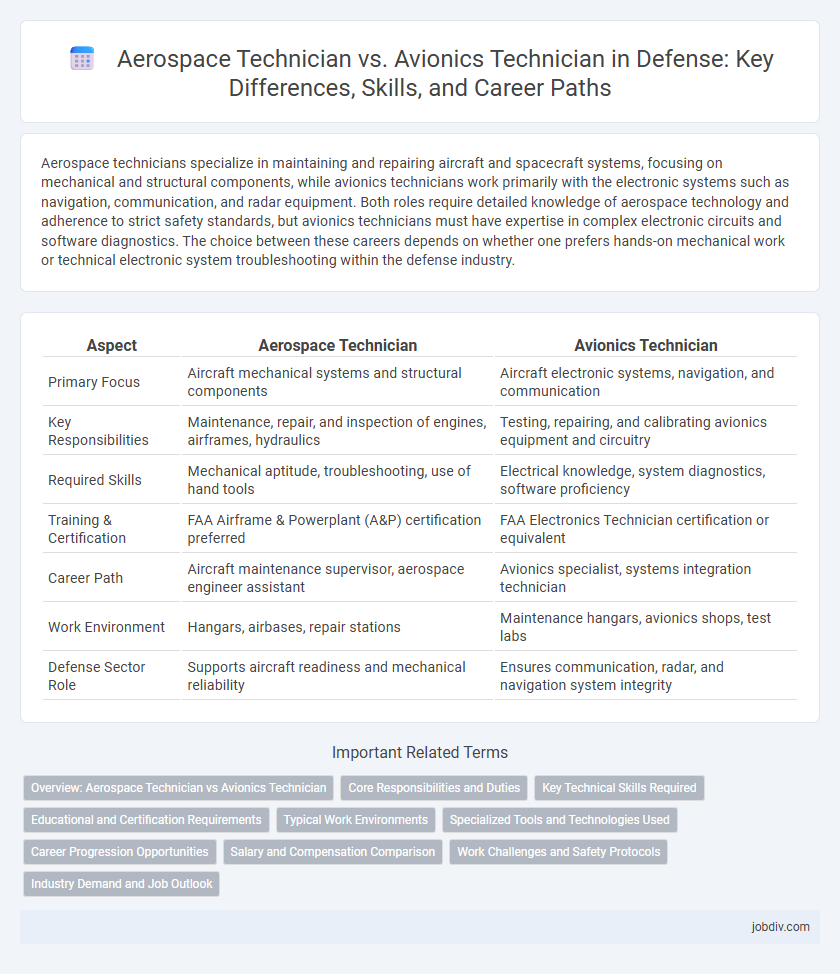Aerospace technicians specialize in maintaining and repairing aircraft and spacecraft systems, focusing on mechanical and structural components, while avionics technicians work primarily with the electronic systems such as navigation, communication, and radar equipment. Both roles require detailed knowledge of aerospace technology and adherence to strict safety standards, but avionics technicians must have expertise in complex electronic circuits and software diagnostics. The choice between these careers depends on whether one prefers hands-on mechanical work or technical electronic system troubleshooting within the defense industry.
Table of Comparison
| Aspect | Aerospace Technician | Avionics Technician |
|---|---|---|
| Primary Focus | Aircraft mechanical systems and structural components | Aircraft electronic systems, navigation, and communication |
| Key Responsibilities | Maintenance, repair, and inspection of engines, airframes, hydraulics | Testing, repairing, and calibrating avionics equipment and circuitry |
| Required Skills | Mechanical aptitude, troubleshooting, use of hand tools | Electrical knowledge, system diagnostics, software proficiency |
| Training & Certification | FAA Airframe & Powerplant (A&P) certification preferred | FAA Electronics Technician certification or equivalent |
| Career Path | Aircraft maintenance supervisor, aerospace engineer assistant | Avionics specialist, systems integration technician |
| Work Environment | Hangars, airbases, repair stations | Maintenance hangars, avionics shops, test labs |
| Defense Sector Role | Supports aircraft readiness and mechanical reliability | Ensures communication, radar, and navigation system integrity |
Overview: Aerospace Technician vs Avionics Technician
Aerospace Technicians specialize in building, testing, and maintaining aircraft and spacecraft systems, focusing on structural components and propulsion mechanisms. Avionics Technicians concentrate on the electronics and communication systems within aircraft, including navigation, radar, and flight control systems. Both roles require expertise in complex technical systems but differ primarily in their emphasis on mechanical structures versus electronic avionics equipment.
Core Responsibilities and Duties
Aerospace Technicians primarily focus on the assembly, maintenance, and repair of aircraft structures, engines, and mechanical systems, ensuring overall airworthiness and compliance with defense standards. Avionics Technicians specialize in the installation, calibration, and troubleshooting of electronic systems such as radar, communication, and navigation equipment critical for mission success. Both roles require expertise in technical diagnostics and adherence to rigorous safety protocols, but aerospace technicians emphasize mechanical integrity while avionics technicians focus on electronic system functionality.
Key Technical Skills Required
Aerospace Technicians require expertise in aircraft structural systems, hydraulic and pneumatic controls, and precision measurement tools to maintain and repair airframes and engines. Avionics Technicians specialize in electronic systems, necessitating skills in radar, navigation, communication equipment, and integrated avionics software diagnostics. Both roles demand proficiency in troubleshooting complex systems, adherence to strict safety protocols, and knowledge of federal aviation regulations.
Educational and Certification Requirements
Aerospace Technicians typically require an associate degree in aerospace technology or a related field, along with certifications such as the Federal Aviation Administration (FAA) Airframe and Powerplant (A&P) license. Avionics Technicians often need an associate degree in avionics or electronics technology, complemented by certifications like the FAA General Radiotelephone Operator License and specialized avionics certifications. Both roles benefit from hands-on experience and ongoing training to stay current with evolving aerospace systems and regulatory standards.
Typical Work Environments
Aerospace technicians commonly work in manufacturing plants, maintenance facilities, and aerospace testing laboratories, focusing on assembling, testing, and repairing aircraft and spacecraft components. Avionics technicians primarily operate in hangars, repair shops, and military bases, specializing in installing, inspecting, and troubleshooting electronic systems used in aircraft navigation, communication, and weaponry. Both roles require strict adherence to safety protocols and coordination with engineering teams to ensure operational readiness and compliance with defense regulations.
Specialized Tools and Technologies Used
Aerospace Technicians utilize tools such as precision measuring instruments, hydraulic test stands, and structural repair systems to maintain and assemble aircraft components. Avionics Technicians focus on advanced diagnostic equipment, oscilloscopes, and software for troubleshooting electronic flight control systems and radar technologies. Both roles require expertise in specialized technologies, but Avionics Technicians emphasize electronic systems while Aerospace Technicians concentrate on mechanical and structural maintenance.
Career Progression Opportunities
Aerospace Technicians often advance into roles involving aircraft structures and systems maintenance, enabling career growth into specialized engineering or quality control positions within the defense sector. Avionics Technicians typically progress by deepening their expertise in electronic systems, moving toward senior diagnostic roles or avionics system integration leadership, which are critical in modern military aircraft operations. Both career paths offer opportunities for certification and training that enhance promotion potential and technical leadership in defense aerospace maintenance.
Salary and Compensation Comparison
Aerospace technicians typically earn an average annual salary of $67,000, while avionics technicians have a slightly higher median salary around $72,000, reflecting specialized skills in electronic systems maintenance. Compensation packages for avionics technicians often include additional bonuses and overtime pay due to the high demand for expertise in avionics technology within defense sectors. Overall, avionics technicians benefit from competitive pay scales and enhanced financial incentives compared to aerospace technicians, driven by the evolving complexity of military aircraft systems.
Work Challenges and Safety Protocols
Aerospace Technicians face challenges in maintaining complex mechanical systems and ensuring airframe integrity under extreme conditions, requiring strict adherence to structural safety protocols and environmental controls. Avionics Technicians encounter difficulties with intricate electronic systems diagnostics and integration, emphasizing rigorous compliance with electromagnetic interference standards and software security measures. Both roles demand precise attention to detail, adherence to military safety regulations, and continuous training to mitigate operational risks in defense aerospace environments.
Industry Demand and Job Outlook
Aerospace Technicians are in high demand due to the growing need for advanced aircraft testing, manufacturing, and maintenance within the defense industry, with job growth projected at 4% over the next decade. Avionics Technicians face strong demand driven by increasing reliance on sophisticated electronic systems and weaponry, with employment expected to grow by 5%, reflecting advancements in radar, communication, and navigation technology. Both careers offer stable outlooks, but avionics roles may provide slightly higher growth opportunities due to expanding electronic warfare systems and unmanned aerial vehicle development.
Aerospace Technician vs Avionics Technician Infographic

 jobdiv.com
jobdiv.com